Scythe Infinity: 5 Heatpipes and Silent 120mm Fan
by Wesley Fink on February 26, 2007 12:05 AM EST- Posted in
- Cases/Cooling/PSUs
Scythe Infinity
Scythe Co., Ltd. is a Japanese company located in Tokyo. Beginning in 2002 Scythe started manufacturing and distributing products for the PC enthusiast. This included CPU cooling solutions. Scythe's first product, the Scythe Samurai, developed quite a reputation among computer enthusiasts.
Scythe produces a wide range of air cooling solutions for the computer enthusiast. There are currently about a dozen air cooling solutions detailed on the company website. These range from entry cooling solutions all the way to full cooling tower designs.
Their current catalog includes the well-known Scythe Infinity and the Scythe Ninja Rev. B full cooling tower solutions at the top. There are also mid to low-end offerings such as the Scythe Katana that was recently reviewed at AnandTech.
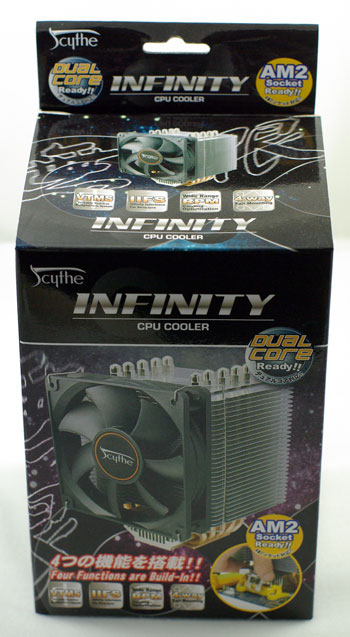
Scythe likes using colorful graphics, but they often put so much information in so many languages on the box that the packaging becomes confusing. The Infinity is a big heatpipe tower, and Scythe use every inch of that big package for information. You can find whatever you want to know about Infinity on the package somewhere - it's just finding what you are looking for is not so easy in that package information explosion.
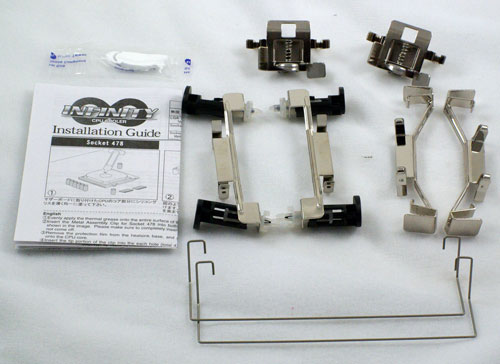
Infinity comes with adapters for 775, AM2, and AMD 754/939/940. The Scythe adapter system is extremely easy to use. Adapters pop into holes on the side of the tower base and no tools are needed for mounting the adapters. It's a very clever mount system.
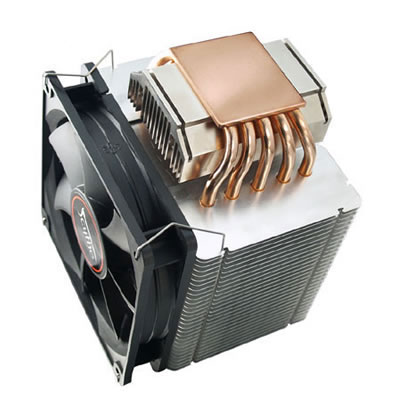
The mounting surface of Infinity is highly polished. It is protected during shipments with an adhesive film that removes leaving no residue.

At first glance it looks as if the Scythe Infinity uses ten heatpipes for cooling, but Scythe specifies the configuration as five heat pipes. The 5 pipes flatten out and pass across the base copper plate, so they form a continuous "U" shape with each heatpipe.
Scythe supplies a packet of very basic thermal compound with the Infinity, but it is nothing special. We used our standard silver-colored thermal grease in our testing, which is what we use in testing all coolers unless they supply a high-end thermal grease with the cooler.
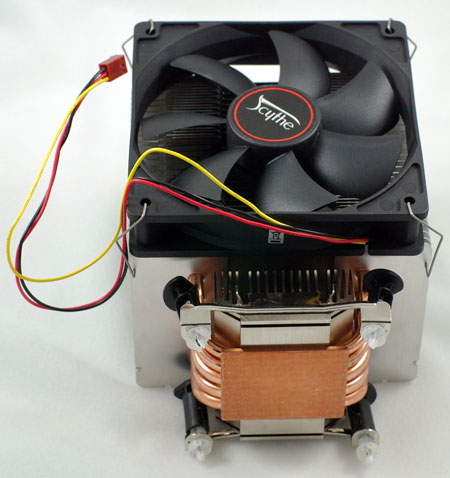
The included low-noise fan can fit on any of the 4 sides of the cooler. Scythe tells us mounting on the larger side of the Infinity provides the best cooling, but the fan may also be mounted on the shorter side if that works better in your configuration.
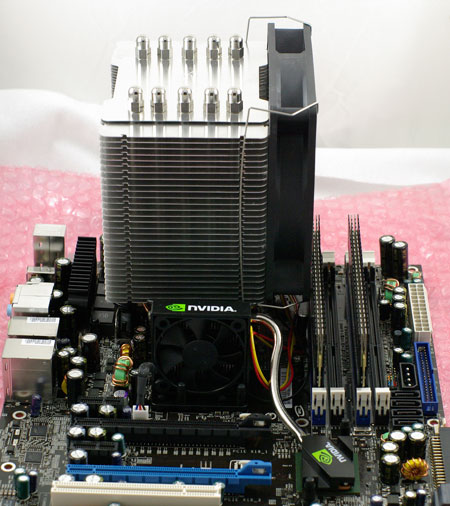
Installation is very easy after the mounting plate is installed. The 775 mount uses push pins - just like the Intel retail design. However easy the mount is, the fact that the Infinity weighs right at 2.2 lbs, or a kilogram, gives reason for pause. It is very uncomfortable having so much weight held by just those pop clips. The Infinity is probably OK in a desktop case, but it is not a mounting system that handles moving the case around or transport to and from a LAN party.
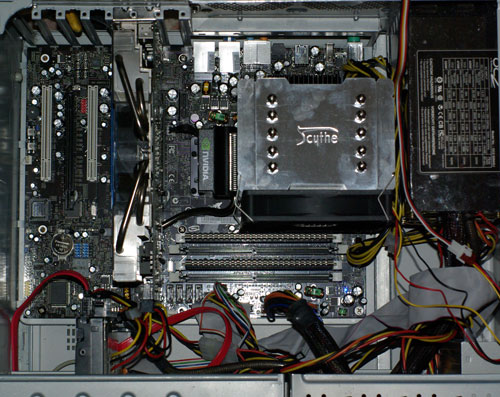
The Infinity does not overhang the DIMM sockets on the EVGA 680i as you can see in the picture above. The fan does come very close however. The mass of the Infinity is also a bit closer to the motherboard than some other heatpipe towers, so the Infinity can be a tight fit on some motherboards. In our installation the EVGA cooling fan on the Northbridge touched the Infinity, meaning the Infinity has to be very carefully aligned on installation. In our first attempt stock idle cooling was 36C, which appeared very high. After a careful remount the stock idle temp dropped to 31C, which was more in line with expected performance.
Specifications
Our test system is Intel Socket 775, but the Scythe Infinity will mount on any current CPU, as already mentioned. All the needed hardware is included to fit the supported sockets.
One 120mm "silent" fan comes with the Scythe Infinity. The Infinity street price is $58, about the same as the current price of the Tuniq Tower 120. If you cannot find a local retailer or etailer that sells the Infinity you can order directly from Scythe USA for $58. Scythe also sells additional fan wires for about $2 per pair. Many etailers also stock the fan wire kits. Any 120mm x 25mm fan should mount on the Infinity. Scythe also manufactures a very large variety of cooling fans sold under the Scythe brand, including models that feature the Sony Fluid Dynamic Bearing. You will find many of these available at etailers like Newegg, 3DCool and Frozen CPU.
Scythe Co., Ltd. is a Japanese company located in Tokyo. Beginning in 2002 Scythe started manufacturing and distributing products for the PC enthusiast. This included CPU cooling solutions. Scythe's first product, the Scythe Samurai, developed quite a reputation among computer enthusiasts.
Scythe produces a wide range of air cooling solutions for the computer enthusiast. There are currently about a dozen air cooling solutions detailed on the company website. These range from entry cooling solutions all the way to full cooling tower designs.
Their current catalog includes the well-known Scythe Infinity and the Scythe Ninja Rev. B full cooling tower solutions at the top. There are also mid to low-end offerings such as the Scythe Katana that was recently reviewed at AnandTech.

Scythe likes using colorful graphics, but they often put so much information in so many languages on the box that the packaging becomes confusing. The Infinity is a big heatpipe tower, and Scythe use every inch of that big package for information. You can find whatever you want to know about Infinity on the package somewhere - it's just finding what you are looking for is not so easy in that package information explosion.

Infinity comes with adapters for 775, AM2, and AMD 754/939/940. The Scythe adapter system is extremely easy to use. Adapters pop into holes on the side of the tower base and no tools are needed for mounting the adapters. It's a very clever mount system.

The mounting surface of Infinity is highly polished. It is protected during shipments with an adhesive film that removes leaving no residue.

At first glance it looks as if the Scythe Infinity uses ten heatpipes for cooling, but Scythe specifies the configuration as five heat pipes. The 5 pipes flatten out and pass across the base copper plate, so they form a continuous "U" shape with each heatpipe.
Scythe supplies a packet of very basic thermal compound with the Infinity, but it is nothing special. We used our standard silver-colored thermal grease in our testing, which is what we use in testing all coolers unless they supply a high-end thermal grease with the cooler.

The included low-noise fan can fit on any of the 4 sides of the cooler. Scythe tells us mounting on the larger side of the Infinity provides the best cooling, but the fan may also be mounted on the shorter side if that works better in your configuration.

Installation is very easy after the mounting plate is installed. The 775 mount uses push pins - just like the Intel retail design. However easy the mount is, the fact that the Infinity weighs right at 2.2 lbs, or a kilogram, gives reason for pause. It is very uncomfortable having so much weight held by just those pop clips. The Infinity is probably OK in a desktop case, but it is not a mounting system that handles moving the case around or transport to and from a LAN party.

The Infinity does not overhang the DIMM sockets on the EVGA 680i as you can see in the picture above. The fan does come very close however. The mass of the Infinity is also a bit closer to the motherboard than some other heatpipe towers, so the Infinity can be a tight fit on some motherboards. In our installation the EVGA cooling fan on the Northbridge touched the Infinity, meaning the Infinity has to be very carefully aligned on installation. In our first attempt stock idle cooling was 36C, which appeared very high. After a careful remount the stock idle temp dropped to 31C, which was more in line with expected performance.
Specifications
Our test system is Intel Socket 775, but the Scythe Infinity will mount on any current CPU, as already mentioned. All the needed hardware is included to fit the supported sockets.
| Scythe Infinity Specifications | |
| Heatsink | |
| Dimensions | 116(L) X 125(W) X 160(H)mm (excluding fan) |
| Weight | 960g (including fan) |
| Material | Pure Copper and Aluminum |
| Fan Configuration | 4-way mount, up to four 120mm Fans can be mounted |
| Fan | |
| Fan Size | 120mm x 120mm x 25mm |
| Noise Level | 23.5 dB-A |
| Speed | 1200 rpm +/- 10% |
| Air Flow | 46.5 CFM |
One 120mm "silent" fan comes with the Scythe Infinity. The Infinity street price is $58, about the same as the current price of the Tuniq Tower 120. If you cannot find a local retailer or etailer that sells the Infinity you can order directly from Scythe USA for $58. Scythe also sells additional fan wires for about $2 per pair. Many etailers also stock the fan wire kits. Any 120mm x 25mm fan should mount on the Infinity. Scythe also manufactures a very large variety of cooling fans sold under the Scythe brand, including models that feature the Sony Fluid Dynamic Bearing. You will find many of these available at etailers like Newegg, 3DCool and Frozen CPU.










39 Comments
View All Comments
Wesley Fink - Monday, February 26, 2007 - link
The famous thermal compound review is at http://www.dansdata.com/goop.htm">http://www.dansdata.com/goop.htm. While it is written tongue-in-cheek the test methods are well conceived and there is a terrific discussion of what is significant and what is trivial in testing computer components. After I read the review a while ago I tested every thermal compound I had spent big bucks on and got very similar results.I will concede that the more fluid compounds do work a little better when you have tiny contact areas as in the older Socket A AMD - at least initially. But with heatspreaders on all the CPUs these days the thermal grease used makes very little difference as long as it holds up, isn't particualrly conductive, and doesn't dry out. Applying it properly can make a big difference in performance, however.
Those not from Oz may recall the Men At Work song "Down Under" that makes reference to a "vegemite sandwich". Now you'll understand Vegemite is that brown vegatable spread about the texture of mayonnaise that is uniquely popular in Austalia.
DrMrLordX - Tuesday, February 27, 2007 - link
While I'll generally agree with you, there is at least one TIM that is positively insane that may outperform the usual gunk, and that's Coollaboratory's Liquid Pro (their Metal Pads don't seem to work as well). That stuff will literally dissolve aluminum and otherwise make a terrible mess. It's mostly gallium, indium, and tin I'm told. Strange stuff.Others swear by Shin-Etsu X23-7783D as being clearly superior to AS5 and AS Ceramique. I've only seen one benchmark featuring the X23, but it even beat the crazy Liquid Pro in that benchmark.
Really, it would be more interesting to see benchmarks of the TIMs themselves than anything else. Your current TIM strategy in your heatsink tests is fine by me.
BigLan - Monday, February 26, 2007 - link
I think the toothpaste and vegemite article is on dansdata. (Dan used to do HSF reviews back in the Socket A days and had literally dozens of them all compared.) While toothpaste might work for testing, it does dry out very quickly and so would need to be replaced after a short period of time (probably days.) You could use it in a pinch, but I wouldn't want to try for 3117 overclocks with it!Binkt - Monday, February 26, 2007 - link
"We have the Thermalright 120 in for review, and we will also be testing the Scythe Ninja Rev. B. Noctua, an Austrian manufacturer of cooling solutions"Could you be specific on the model of thermalright 120 that you have in for upcoming tests? I assume that you mean the Ultra-120, since it is the current heavy-hitter from my personal favorite manufacturer.
Thanks, and keep up the great work!
PS. Any hope for a look at virtualization performance of current CPU's and platforms? hint: Asrock 775Dual-VSTA vs. more expensive i965 boards vs. AMD VT-enabled platforms ?
Wesley Fink - Monday, February 26, 2007 - link
The cooler is the Thermalright Ultra 120.lopri - Monday, February 26, 2007 - link
It's got to be Ultra-120. I'd personally rate Tuniq 120, Scythe Infinity, and Ultra-120 as top 3 air coolers today. BTW, what does this article have to do with virtualization??To Wesley: Thanks for the article. And I totally agree with your assessment on Infinity's mounting mechanism. It flexes motherboard and makes me uncomfortable to have it in my tower. Also it might not block DIMM slots on the tested motherboard, but I had some difficulties on other boards. (especially if I wanted to make use of any RAM cooling)
Did Infinity go through revisions? If so, what are the differences from original model and the current one?
thestain - Monday, February 26, 2007 - link
Making comparisons based upon 38 dba is not a real test of quietness, try to get your rig a little quieter, maybe shoot for 33-34 so we can see these products spread themselves out more. Have you made any effort to test your test rig to see if the Power supply is making too much racket, in qhixh case replace it with a comparable performing Corsair or Seasonic, and can you turn down the fan slightly on your graphics card??Wesley Fink - Monday, February 26, 2007 - link
With all computers, monitors, printers, lamps, etc. turned off in our testing romm the ambient noise is 36.4db. Reaching 33 to 34db as a base is therefore not likely. The OCZ 520 is one of the quietest power supplies we have tested. We have also tested with a small basic video card just to see if noise can be lowered further. The result was we had reached the floor of the PS. We also have to unplug the nVidia northbridge fan during noise measurements because it is much louder than the PS, video card fan or most coolers that we have tested.There is a place for fanless power supplies, fanless video cards, and coolers that are silent, but for the great bulk of readers we really see little point in testing below the noise floor of the power supply.
We could do like some other sites and isolate the test board in a sound chamber away from the power supply, but I seriously doubt this is how our readers run their silent PCs. We definitely hear what you are saying, but our noise testing is looking at real-world noise levels. There are other sites that specialize in silence at levels you would more likely find in a noise testing lab.
cujo - Monday, February 26, 2007 - link
you're forgetting a very popular cooler. i'd love to see the results of that vs. these other coolers.i would also suggest looking at motherboard/chipset temperatures as most of these tower coolers do nothing for those.
DrMrLordX - Tuesday, February 27, 2007 - link
I'm sure they'll get around to it eventually . . . that or the Big Typhoon VX.The article is well-done though, and I'm very glad that you did the dual-fan setup guys. If you look at other tests of the Infinity with dual fans, you'll find that using anything faster than 1200rpm in a push-pull config is really unnecessary. Once you have the second fan going you're getting the best you can get out of the Infinity.